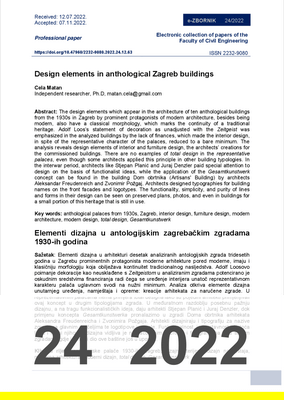ISSN 2232-9080
DESIGN ELEMENTS IN ANTHOLOGICAL ZAGREB BUILDINGS
- Issue: No. 24, December 2022, Vol. 12
- Author(s): Cela Matan
- Type: Professional paper
- DOI: https://doi.org/10.47960/2232-9080.2022.24.12.63
Abstract: The design elements which appear in the architecture of ten anthological buildings from the 1930s in Zagreb by prominent protagonists of modern architecture, besides being modern, also have a classical morphology, which marks the continuity of a traditional heritage. Adolf Loos’s statement of decoration as unadjusted with the Zeitgeist was emphasized in the analyzed buildings by the lack of finances, which made the interior design, in spite of the representative character of the palaces, reduced to a bare minimum. The analysis reveals design elements of interior and furniture design, the architects’ creations for the commissioned buildings. There are no examples of total design in the representative palaces, even though some architects applied this principle in other building typologies. In the interwar period, architects like Stjepan Planić and Juraj Denzler paid special attention to design on the basis of functionalist ideas, while the application of the Gesamtkunstwerk concept can be found in the building Dom obrtnika (Artisans' Building) by architects Aleksandar Freudenreich and Zvonimir Požgaj. Architects designed typographies for building names on the front facades and logotypes. The functionality, simplicity, and purity of lines and forms in their design can be seen on preserved plans, photos, and even in buildings for a small portion of this heritage that is still in use.
Keywords: anthological palaces from 1930s, Zagreb, interior design, furniture design, modern architecture, modern design, total design, Gesamtkunstwerk







